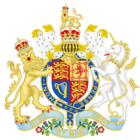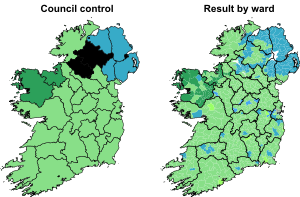Local Government (Ireland) Act 1898 facts for kids
| Act of Parliament | |

|
|
| Long title | An Act for amending the Law relating to Local Government in Ireland, and for other purposes connected therewith. |
|---|---|
| Citation | 61 & 62 Vict. c. 37 |
| Introduced by | Gerald Balfour |
| Territorial extent | Ireland |
| Dates | |
| Royal assent | 12 August 1898 |
|
Status: Repealed
|
|
The Local Government (Ireland) Act 1898 was an important law passed by the UK Parliament. It changed how local areas in Ireland were governed. Before this Act, local government was mostly controlled by wealthy landowners. This new law brought a system similar to what was already in place in England, Wales, and Scotland. It gave more power to ordinary people to elect their local leaders.
Contents
Why the Act Was Needed
For many years, changing how local areas were run in Ireland was a big political issue. Many different groups, including Irish politicians and major British political parties, were involved. There were also big discussions about how Ireland should be governed overall, who should own land, and Irish nationalism.
The government at the time, led by Lord Salisbury, decided to introduce this law in 1898. They hoped it would help solve several problems. It was meant to calm down demands for Home Rule (Ireland governing itself) from Irish Nationalists. It also aimed to make local government more efficient and fair, especially for landowners who paid taxes. By making Ireland's local government more like Britain's, the government also hoped to strengthen the link between Ireland and the rest of the United Kingdom.
Old Ways of Local Government
Counties and Baronies
Before 1898, each county in Ireland was managed by a group called a grand jury. These groups were made up of major landowners chosen by a judge. Originally, grand juries handled court cases, but over time, they also took on tasks like maintaining roads, bridges, and hospitals. They would propose projects, and if a judge approved, money would be raised through a local tax called a "county cess." This tax was paid by landowners and people living in the county.
Below the county level, there were smaller areas called baronies. Here, local judges would meet to raise money for smaller projects.
The problem was that by the 1880s, most members of these grand juries and baronial sessions were Unionist and Protestant. This meant they didn't represent the majority of the population in the areas they governed. They were chosen from the biggest taxpayers, as it was thought they would be most careful with the tax money. However, a new law in 1884, the Representation of the People Act 1884, allowed many more people to vote. These new voters wanted to elect local representatives who truly spoke for them, not just a small group of wealthy people.
Poor Law Unions and Health Districts
In 1838, Ireland was divided into areas called poor law unions (PLUs). Each PLU had a workhouse to help the poor. These areas were managed by elected groups called Boards of Guardians.
As the population grew, there was a need for authorities to manage public health, like sewerage and water supply. The Public Health (Ireland) Act 1878 created sanitary districts. Larger towns became "urban sanitary districts," and their existing town councils managed public health. The rest of the country was divided into "rural sanitary districts," which were managed by the poor law guardians.
Attempts to Change Things Before 1898
Ideas for elected county councils in Ireland first came up in 1885. At that time, the number of people who could vote had just increased a lot. However, early attempts to pass a law for Irish Home Rule failed.
In 1888, elected county councils were introduced in England and Wales, and in 1889 in Scotland. But similar changes were delayed in Ireland due to unrest and protests. The government argued that order needed to be restored before such reforms could happen. Many Unionists and landlords also tried to delay the changes. They worried that new elected councils would be disloyal and try to remove them from power.
In 1891, the Chief Secretary for Ireland, Arthur Balfour, announced that a local government law would be introduced. Even with protests, he decided to go ahead. When the bill was introduced in 1892, it included some "safeguards" to protect the Unionist minority. For example, people who paid more taxes would have more votes, and councils could be dismissed for bad behavior. However, almost all Irish politicians rejected this bill, and it was eventually dropped.
New Government, New Approach
After a change in government, Gerald Balfour became the Chief Secretary for Ireland in 1895. He famously said the new government's policy for Ireland was "killing home rule with kindness." This meant they would try to improve life in Ireland so much that people wouldn't want Home Rule anymore. Over the next few years, the British government passed several important laws for Ireland, including the Local Government Act.
The idea for the local government law in 1898 came as a surprise. There wasn't a huge public demand for it. However, it became a way to solve a political problem in the British Parliament. Irish Members of Parliament (MPs) were causing delays with other laws. Also, landlords were upset about not getting certain tax breaks.
The government realized that introducing democratic county councils, along with a significant tax subsidy, would likely make all Irish MPs happy. They quickly prepared the new law, adapting parts of existing English and Scottish local government acts for Ireland.
The Big Changes of the Act
The 1898 Act created a new system of local government. It set up:
- County Boroughs: These were major cities that would manage their own affairs, separate from the county administration.
- County Councils: These were new elected bodies for each county.
- Urban and Rural District Councils: These were smaller councils within the counties, managing local services in towns and rural areas.
This new system had a huge impact on Ireland. It allowed many more local people to make decisions about their own areas. The new county and district councils became important places for politicians who supported Irish Home Rule. This weakened the influence of Unionists in many places. The Act also helped create a new group of experienced politicians who would later play a big role in national politics in Ireland in the 1920s.
County Boundaries Changed
The Act also led to some changes in county boundaries. This happened for a few reasons:
- Each new district had to be entirely within one county.
- If a town or poor law union was split across two counties, the new district would be placed fully in the county where most of its population lived.
- Some old "corporate counties" (cities that were also their own counties) were merged into their parent counties.
For example, the cities of Belfast and Derry became separate county boroughs. Other areas like Carrickfergus and Drogheda, which used to be their own counties, became part of larger counties. These changes officially took effect on April 18, 1899.
What Happened Next
The way people voted in local elections changed in 1919 to a system called single transferable vote (STV). After Ireland was divided into the Irish Free State (now Ireland) and Northern Ireland in the 1920s, local government developed differently in each place.
In the Irish Free State, rural district councils were abolished in 1925. Urban districts were later renamed "towns" and then abolished in 2014, replaced by new "municipal districts." The way county and city councils operated also changed significantly.
In Northern Ireland, the STV voting system was abolished in 1922. The two-tier county and district system continued until 1973, when it was replaced by a system of 26 single-tier districts.
See also
- List of Irish local government areas 1898–1921
- Local government in the Republic of Ireland
- List of rural and urban districts in Northern Ireland



